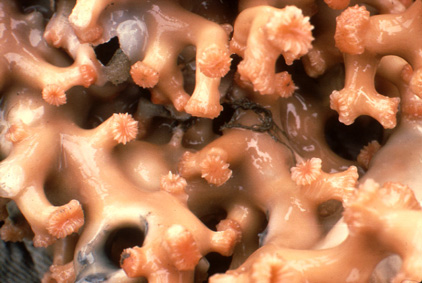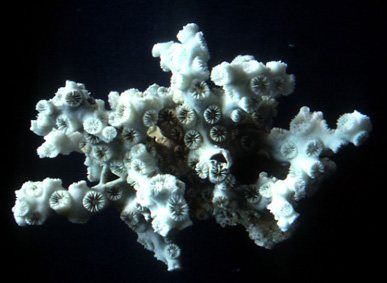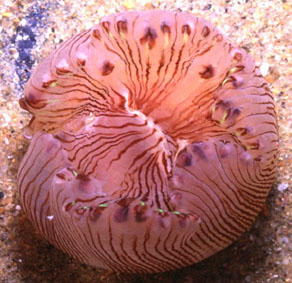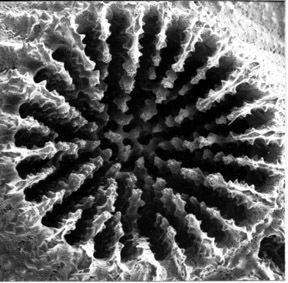
1 |

2 |
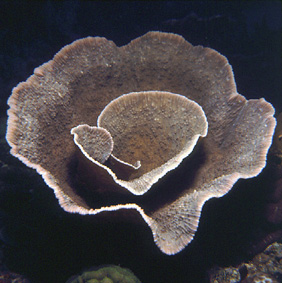
3 |
|
Scleractinia,
Dendrophylliina
Tubastraea micrantha: A living colony having branches about 2 cm in diameter,
collected from shallow water off Pelau. Although azooxanthellate, this
species often attains a colony size of up to a meter and thus contributes
to reef structure. (Photograph courtesy of D. Faulkner).
Permission pending.
|
Scleractinia,
Caryophylliidae
Euphyllia ancora A living colony covered with expanded tentacles, collected
from shallow water off Pelau. This species belongs to the sixth species
group, which consists exclusively of shallow water, zooxanthellate, reef
corals. (Photograph courtesy of D. Faulkner)
Permission pending.
|
Dendrophylliina
Turbinaria sp.: A living colony about 1 m in diameter, collected from
shallow water off Pelau. This is an attached, colonial dendrophylliid
that contains zooxanthellae and contributes to reef structure.(Photo courtesy
of D. Faulkner)
Permission pending.
|

8 |
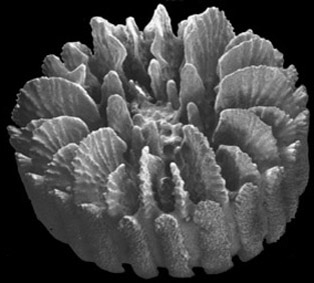
9 |
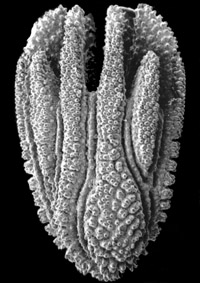
10 |
|
Rhizangiidae
Culicia hoffmeisteri : Calice of an individual corallite from a colonial
skeleton collected from Victoria, Australia (depth 7 m). Diameter of corallite
5.5 mm (from Cairns and Parker, 1992).
Permission received
|
Turbinoliidae
Dunocyathus parasiticus: The anthocyathus (distal portion) of a skeleton
collected off Cape Jaffa, South Australia (depth 165 m). Note that in
this species the costae alternate in position with the septa. Calicular
diameter 4.4 mm (from Cairns & Parker, 1992).
Permission received
|
Turbinoliidae
Holcotrochus scriptus: Side view (SEM) of a corallum collected from Kangaroo
Island, South Australia (depth 108 m). This is one of the smallest of
the scleractinian corals (height 2.3 mm) and has a unique shape and costal
morphology (from Cairns & Parker, 1992).
Permission received
|
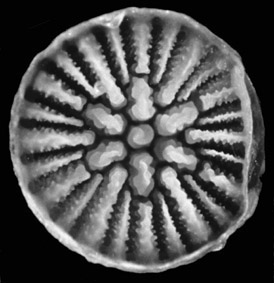
11 |

12 |
|
Flabelloidea
Stenocyathus vermiformis: Calicular view of a specimen collected from
the Bass Strait, Australia (depth 1500 m), showing six pali and a fascicular
columella. Calicular diameter 4.8 mm (from Cairns and Parker, 1992). This
species is an example of the family Guyniidae.
Removed.
|
Dendrophylliina
Notophyllia recta: Calicular view (SEM) of a skeleton collected off Victoria,
Australia (depth 110 m), exemplifying a solitary, unattached dendrophylliid.
Greater calicular diameter 5 mm (from Cairns and Parker, 1992).
Permission received
|
| Cairns, S. D. and S. A. Parker. 1992.
Review of the Recent Scleractinia (Stony Corals) of South Australia, Victoria
and Tasmania. Records of the South Australian Museum, Monograph Series,
3: 82 pp. |

13 |
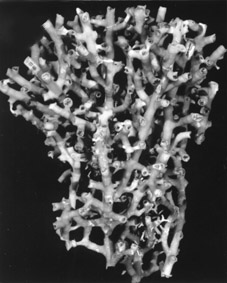
14 |

15 |
|
Fungiacyathidae
Fungiacyathus marenzelleri: Calicular view of the skeleton of a specimen
collected off northwestern New Zealand (depth 2431 m). Diameter of corallum
35 mm (from Cairns, 1995).
Permission received
|
Caryophylliidae
Goniocorella dumosa: Skeleton of a colony collected from off Auckland
Island, New Zealand (depth 421 m). Height of corallum 120 mm (from Cairns,
1995). This species represents those caryophylliids having an attached,
colonial corallum, as well as belonging to the fifth group of species.
Goniocorella dumosa is the predominant framework coral of deep-water coral
banks in the temperate southwest Pacific Ocean.
Permission received
|
Oculininae
Oculina virgosa: Skeleton of a colony collected from off North Cape,
New Zealand (depth 40 m). Height of corallum 150 mm (from Cairns, 1995).
Permission received
|
| Cairns, S. D. 1995. The marine fauna of New Zealand: Scleractinia
(Cnidaria: Anthozoa). New Zealand Oceanographic Institute Memoirs, 103:
210 pp. |

16 |

17 |
|
Anthemiphyllidae
Anthemiphyllia patera: Calicular and basal views of skeletons collected
from St. Vincent, Lesser Antilles (depth 744 m), the latter view showing
the porcellaneous base. Corallum 13 mm in diameter (from Cairns, 1979).
Permission pending.
|

18 |
image missing |
| 19 |
|
Turbinoliidae
Trematotrochus corbicula: SEM of part of wall showing thecal perforations.
Specimen collected from Straits of Florida (depth 576 m). Coralla only
2-3 mm in height, the perforations about 40 mm in diameter (from Cairns,
1979).
Permission pending.
|
Guyniidae
Schizocyathus fissilis: Side view of upper corallum showing lines of
incipient fracture. Corallum from Barbados (depth 200 m); calicular diameter
3.2 mm (from Cairns, 1979).
Removed.
|
| Cairns, S. D. 1979. The deep-water Scleractinia of the
Caribbean Sea and adjacent waters. Studies on the Fauna of Curaçao
and other Caribbean Islands, 57: 341 pp. |
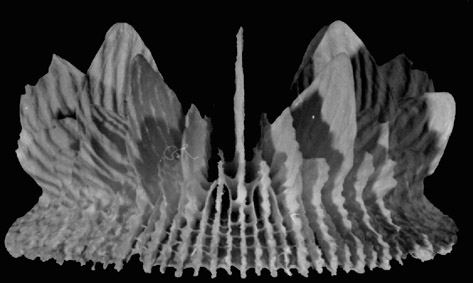
22 |
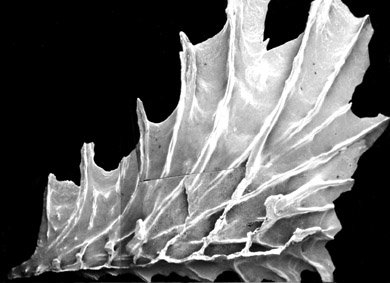
23 |
|
Fungiacyathidae
F. stephanus: Side view of a skeleton that was collected from Indonesia
(depth 798 m). Diameter of corallum 37 mm (from Cairns, 1989).
|
Fungiacyathidae
F. marenzelleri: Side view of an isolated septum, showing trabecular
ridges and synapticulae on the septal face. Specimen collected from off
California (depth 4100 m). Length of septum 10 mm (from Cairns, 1994).
|
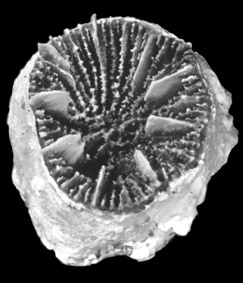
24 |

25 |
|
Rhizangiidae
Oulangia bradleyi Calice of an individual corallite from a colonial skeleton
collected at the Galapagos (depth 14 m). Diameter of corallite 12.2 mm
(from Cairns, 1991).
|
Rhizangiidae
Astrangia haimei : Skeleton of a symmetrically growing colony collected
from shallow water off Monterey, California. Colony 50 mm in diameter
(from Cairns, 1994).
|

26 |
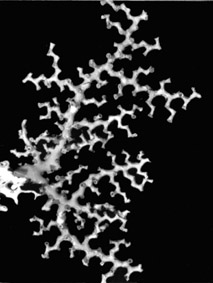
27 |
|
Oculininae
O. profunda: SEM of paratype branch fragment collected off California
(depth 578 m). Branch about 3.5 mm thick (from Cairns, 1994).
|
Oculininae
Madrepora oculata: A flabellate colony collected from the Galapagos (depth
717 m). This is one of about a dozen coral species to have a cosmopolitan
distribution. Height of colony 100 mm (from Cairns, 1991).
|

28 |
|
Anthemiphyllidae
Anthemiphyllia frustum: Oblique calicular view and SEM detail of septal
spines of a skeleton collected from Kyushu, Japan (depth 237 m). Diameter
of corallum 8.2 mm (from Cairns, 1994).
|
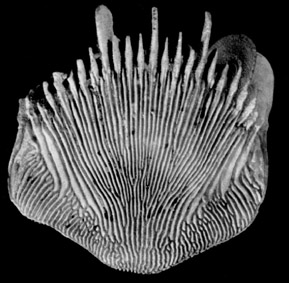
29 |
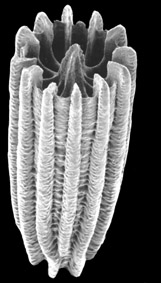
30 |
|
Turbinoliidae
Alatotrochus rubescens: Side view of skeleton collected from Kyushu Island,
Japan (depth 193 m), characterized by having prominent edge crests and
twice as many costae as septa. Height of corallum 14 mm (from Cairns,
1994).
|
Scleractinia,
Turbinoliidae
Turbinolia stephensoni: Oblique SEM view of skeleton collected from the
Arafura Sea (depth 24 m). This species has the smallest adult corallum
of any scleractinian, this specimen being only 2 mm in height (from Cairns,
1997).
|
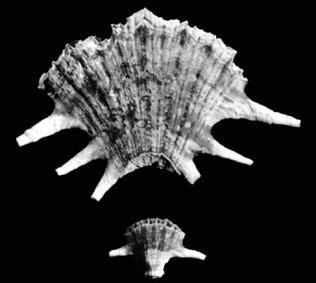
31 |
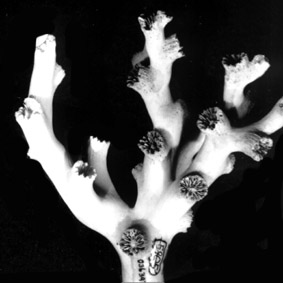
32 |
|
Flabellidae
Truncatoflabellum candeanum: The neotype specimen, including both anthocaulus
(basal) and anthocyathus (distal) stages, collected from the Philippines
(depth 194 m). Greater calicular diameter 18 mm (from Cairns, 1989a).
|
Dendrophylliina
Dendrophyllia oldroydae: Holotypic colony, collected from off California
(depth 366 m). This species is an example of a colonial, azooxanthellate
dendrophylliid. Colony 83 mm in height (from Cairns, 1994).
|

33 |
|
Caryophylliidae
Cut away diagram of a specimen of Caryophyllia illustrating the basic
morphological features of an attached, solitary scleractinian (from Cairns,
1994).
|
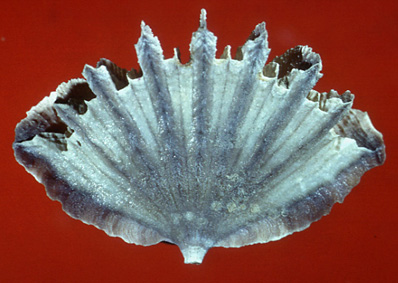
34 |

35 |
|
Caryophylliina
Flabellum deludens: Side view of a skeleton collected from the Philippines
(depth 289 m). This species represents the superfamily Flabelloidea. Width
of corallum 45 mm.
|
Scleractinia,
Caryophylliina
Deltocyathus rotulus Calicular view of a skeleton collected from off
Sabah, Borneo (depth 871 m). This species represents the superfamily Caryophyllioidea.
Diameter of calice 30 mm.
|

36 |
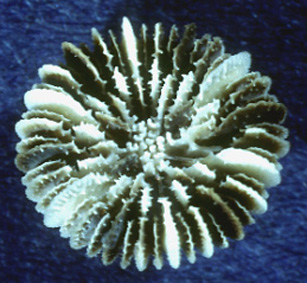
37 |
|
Caryophyllioidea
Cyathotrochus pileus: Side view of a skeleton collected from the Philippines
(depth 494 m). Note the deep intercostal grooves. Width of corallum 23
mm. This species represents the family Turbinoliidae.
|
Caryophyllioidea
Deltocyathus calcar : Calicular view of skeleton collected off St. Vincent,
Lesser Antilles (depth 231 m). Diameter of corallum 11 mm. This species
represents the family Caryophylliidae.
|
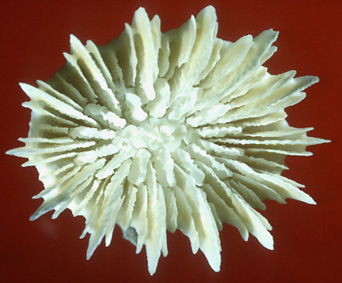
38 |
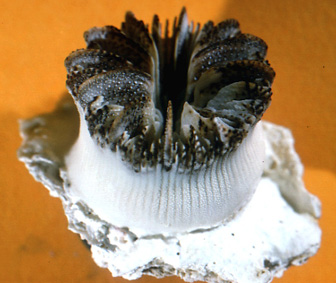
39 |
|
Caryophylliidae
Caryophyllia ambrosia: Calicular view of a skeleton collected from St.
Christopher, Lesser Antilles (depth 622 m). Greater diameter of corallum
34 mm. This species represents caryophylliids having an unattached, solitary,
cornute growth form, as well belonging to the second group of species.
|
Caryophylliidae
Rhizosmilia maculata: Oblique calicular view of a skeleton collected
from St. Vincent, Lesser Antilles (depth 241 m). Calicular diameter 18
mm.
|
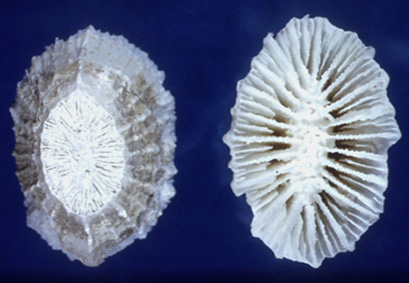
40 |
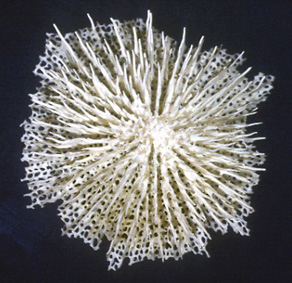
41 |
|
Flabelloidea
Truncatoflabellum truncum: Calicular and basal views of a skeleton collected
from off Chile (depth 1500 m), the basal view showing the detachment scar
from asexual transverse division. Greater calicular diameter 30 mm. This
species is an example of the family Flabellidae.
|
Micrabaciidae
Leptopenus antarctica: Calicular view of the extremely delicate skeleton
of the holotypic specimen, collected from Ross Sea, Antarctica (depth
2032 m). Diameter of corallum 18 mm.
|

42 |

43 |
|
Oculininae
M. carolina: A flabellate colony showing sympodial branching pattern,
collected from Rosalind Bank, Nicaragua, Caribbean (depth 162 m). Height
of colony 460 mm.
|
Fungiacyathidae
F. stephanus: Same specimen as above; oblique view.
|

44 |
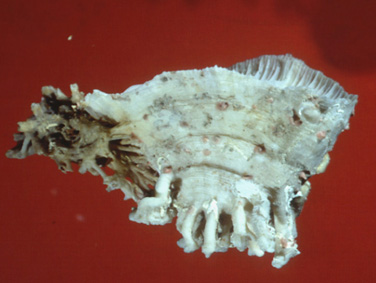
45 |
|
Flabellidae
Flabellum apertum: Calicular view of a skeleton collected from the Macquarie
Ridge (depth 1647 m), an example of a free-living flabellid. Greater calicular
diameter 27 mm.
|
Flabellidae
Rhizotrochus typus: Side view of a skeleton collected from the Philippines
(depth 124 m), this genus characterized by tubular hollow basal rootlets
that help attach the coral to the substrate. Height of corallum 43 mm.
|
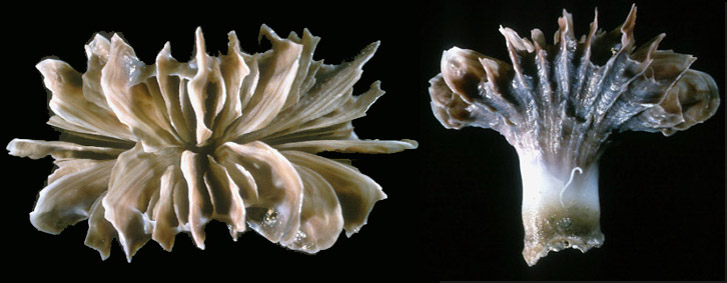
46 |
|
Flabellidae
Javania lamprotichum: Calicular and side views of a corallum collected
from the Tongue of the Ocean, Bahamas (depth 1234 m), an example of a
firmly attached flabellid.
|

47 |
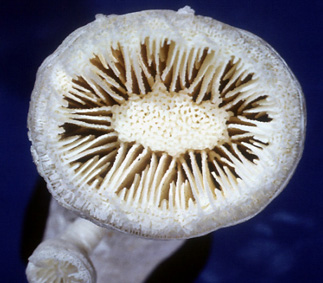
48 |
|
Guyniidae
Guynia annulata: Calicular view (SEM) of fossil specimen collected from
Late Pliocene of Panama, showing octameral septal arrangement and some
mural pores. This species is known from the Pliocene to Recent and is
one of the smallest known scleractinian corals, this specimen having a
calicular diameter of 0.9 mm.
|
Dendrophylliina
Balanophyllia malouinensis: Calicular view of a skeleton collected from
Tierra del Fuego (depth 512 m), illustrating the Pourtalès plan
of septal arrangement. This species is an example of a solitary, attached
dendrophylliid. Greater calicular diameter 12 mm.
|

49 |
|
Dendrophylliina
Composite cross-sectional diagram of a calice illustrating various septal
insertion patterns: upper right system with three cycles of septa, upper
left system with four cycles, and lower two systems with various stages
of development of the Poutralès plan. Numbers refer to cycle to
which septa belong (from Cairns, 1994)
|



